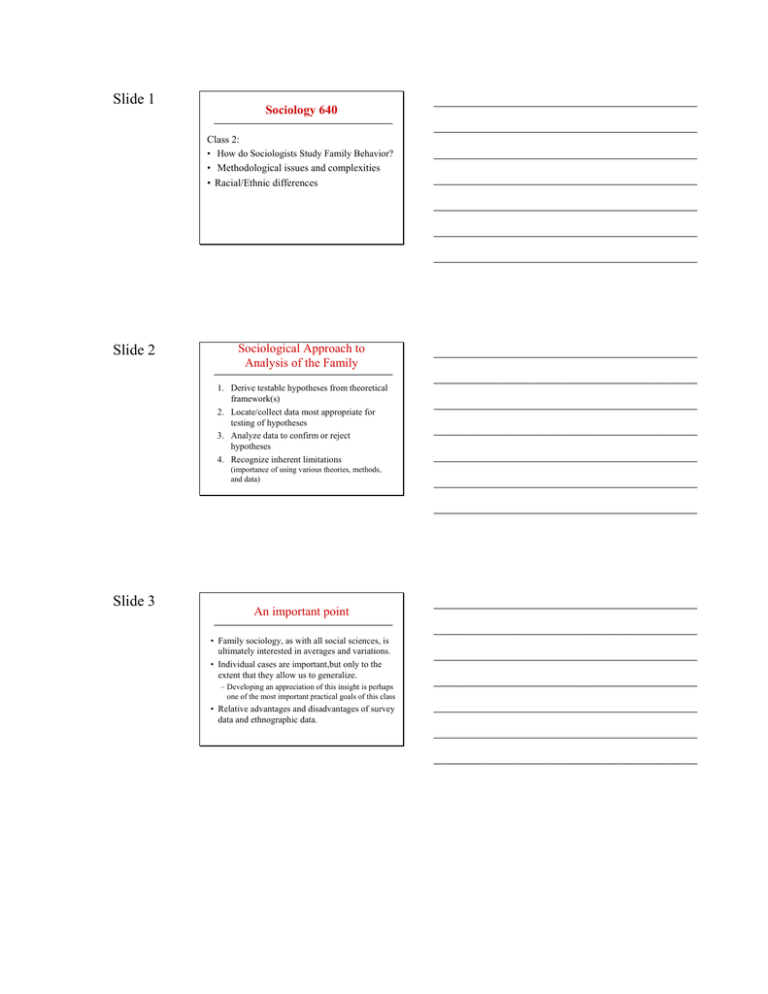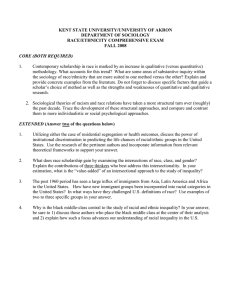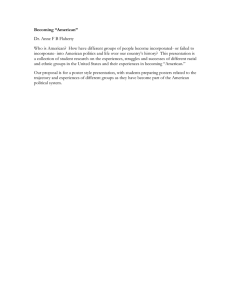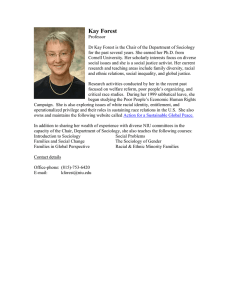Slide 1 ___________________________________
advertisement

Slide 1 Sociology 640 ___________________________________ ___________________________________ Class 2: • How do Sociologists Study Family Behavior? ___________________________________ • Methodological issues and complexities • Racial/Ethnic differences ___________________________________ ___________________________________ ___________________________________ ___________________________________ Slide 2 Sociological Approach to Analysis of the Family ___________________________________ ___________________________________ 1. Derive testable hypotheses from theoretical framework(s) 2. Locate/collect data most appropriate for testing of hypotheses 3. Analyze data to confirm or reject hypotheses 4. Recognize inherent limitations (importance of using various theories, methods, and data) ___________________________________ ___________________________________ ___________________________________ ___________________________________ ___________________________________ Slide 3 An important point ___________________________________ ___________________________________ • Family sociology, as with all social sciences, is ultimately interested in averages and variations. • Individual cases are important,but only to the extent that they allow us to generalize. – Developing an appreciation of this insight is perhaps one of the most important practical goals of this class • Relative advantages and disadvantages of survey data and ethnographic data. ___________________________________ ___________________________________ ___________________________________ ___________________________________ ___________________________________ Slide 4 Theoretical Frameworks for Studying the Family ___________________________________ ___________________________________ • Functionalism • Exchange Theory • Conflict Perspective • Symbolic Interaction • Feminist Theory ___________________________________ ___________________________________ ___________________________________ ___________________________________ ___________________________________ Slide 5 Study of the Family Analysis of variation and change • Historical approach • Comparative approach • Group differences • Life Course approach ___________________________________ ___________________________________ ___________________________________ ___________________________________ ___________________________________ ___________________________________ ___________________________________ Slide 6 Data used to Study the Family • Survey data – – – – Random sample Large scale Allows for generalization Allows for comparison of many groups • Ethnographic data – Usually non-random sample – Small scale – Allows for much more nuanced analysis ___________________________________ ___________________________________ ___________________________________ ___________________________________ ___________________________________ ___________________________________ ___________________________________ Slide 7 Methodological notes • Pay attention to the variety of measures cited in these early articles. • For example: – divorce rates vs. probability that marriage ends in divorce – proportion of children living in single-parent families vs. likelihood of ever living in a singleparent family vs. proportion of childhood spent in single-parent family – Mean age at marriage vs. median age at marriage vs. proportion never marrying ___________________________________ ___________________________________ ___________________________________ ___________________________________ ___________________________________ ___________________________________ ___________________________________ Slide 8 Complexities • Non-linearities e.g., Wives’ earnings and marital stability • Interactions e.g., marital discord and effect of divorce on children ___________________________________ ___________________________________ ___________________________________ ___________________________________ ___________________________________ ___________________________________ ___________________________________ Slide 9 Racial and Ethnic Differences in Family • Important differences in family structure • Differences in marriage and childbearing patterns • Economic differences – esp. in “persistent poor” ___________________________________ ___________________________________ ___________________________________ ___________________________________ ___________________________________ ___________________________________ ___________________________________ Slide 10 Racial and Ethnic Differences in Children’s Family Structure 1995 80 ___________________________________ ___________________________________ 76 70 ___________________________________ 63 60 52 50 40 33 ___________________________________ 28 30 18 20 11 10 3 4 3 4 4 ___________________________________ 0 White Both Parents Black Mother Only Hispanic Father Only Neither Parent ___________________________________ ___________________________________ Slide 11 Family Status and Poverty, 1990 ___________________________________ ___________________________________ 60 53.4 50 ___________________________________ 37.2 40 ___________________________________ 30 19.9 20 13.5 12 Total Householder ___________________________________ 10 0 Children Female HH Children in Female HH ___________________________________ ___________________________________ Slide 12 Racial/Ethnic Differences • Words of caution: – Tremendous variation within racial and ethnic groups – Overlap between race and class – Multivariate analyses key to understanding racial differences – Increasing difficulty of making racial comparisons ___________________________________ ___________________________________ ___________________________________ ___________________________________ ___________________________________ ___________________________________ ___________________________________ Slide 13 ___________________________________ Racial and Ethnic Differences in Marriage and Childbearing NON-HISPANIC White African American 17 HISPANIC Mexican American Puerto Rican Cuban American Other 33 5 41 10 13 ___________________________________ 56 18 ASIAN/PACIFIC ISL. Chinese American Japanese American Hawaiian Filipino American Other ___________________________________ 67 ___________________________________ 45 16 NATIVE AMERICAN Amer. Ind./Alaskan ___________________________________ 54 0 20 40 60 80 Percent of mothers who were not married ___________________________________ ___________________________________ Slide 14 What does Family Sociology contribute? • Attempts to accurately describe trends/changes in family behavior (e.g., emergence of nuclear family, emergence of cohabitation). • Recognizes complexity of factors influencing family change/variation. Attempts to theoretically untangle causal relationships (e.g., attitudes and divorce). * Recognizes that correlation does not imply causation (e.g., women’s education and marriage). • Attempts to objectively assess implications of family behavior and changes therein (e.g., impact of divorce/stepfamilies on children). (But see Cowan note for alternative view) ___________________________________ ___________________________________ ___________________________________ ___________________________________ ___________________________________ ___________________________________ ___________________________________ Slide 15 More questions for thought • Are you optimistic about family change over the next 30 years? Pessimistic? • What do you think will be important family changes/issues for your generation? • What do you think will be important family changes/issues for you? ___________________________________ ___________________________________ ___________________________________ ___________________________________ ___________________________________ ___________________________________ ___________________________________




